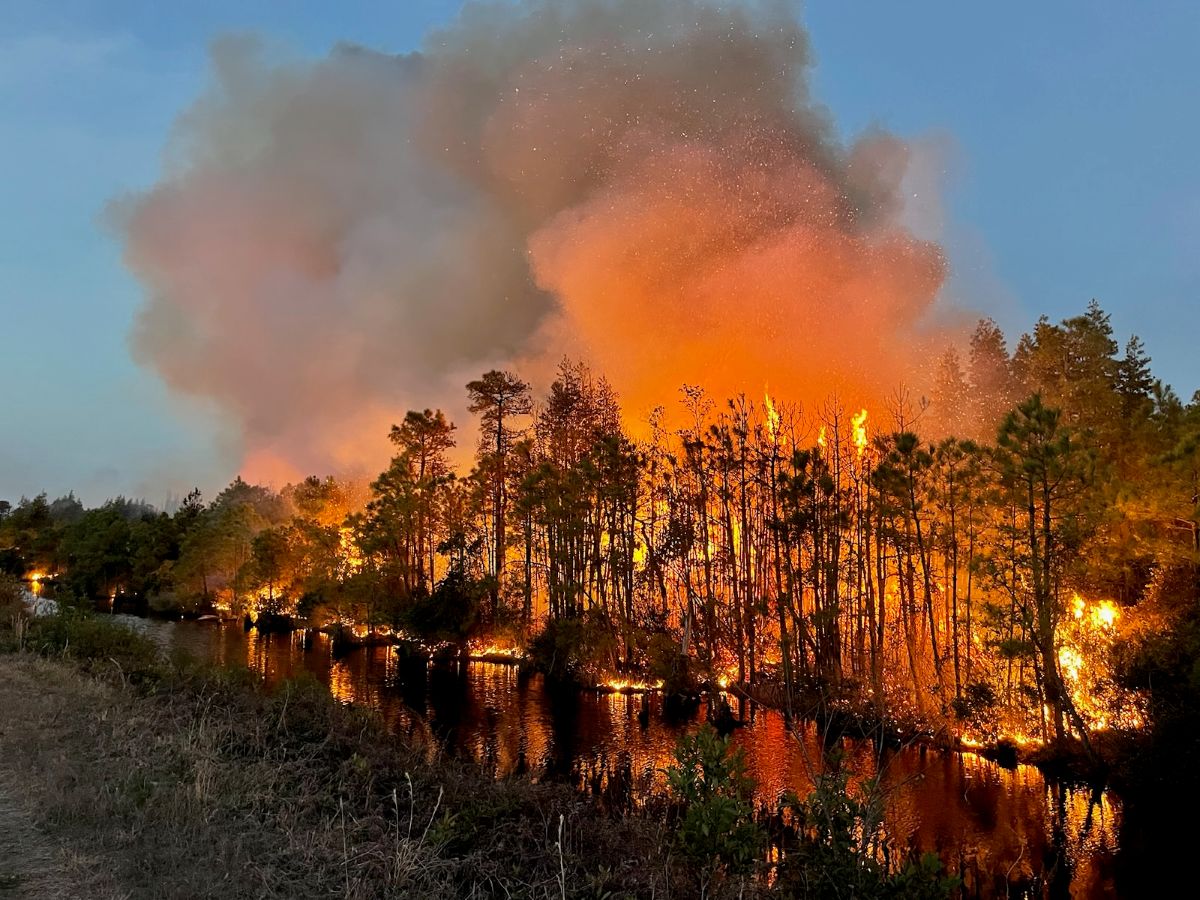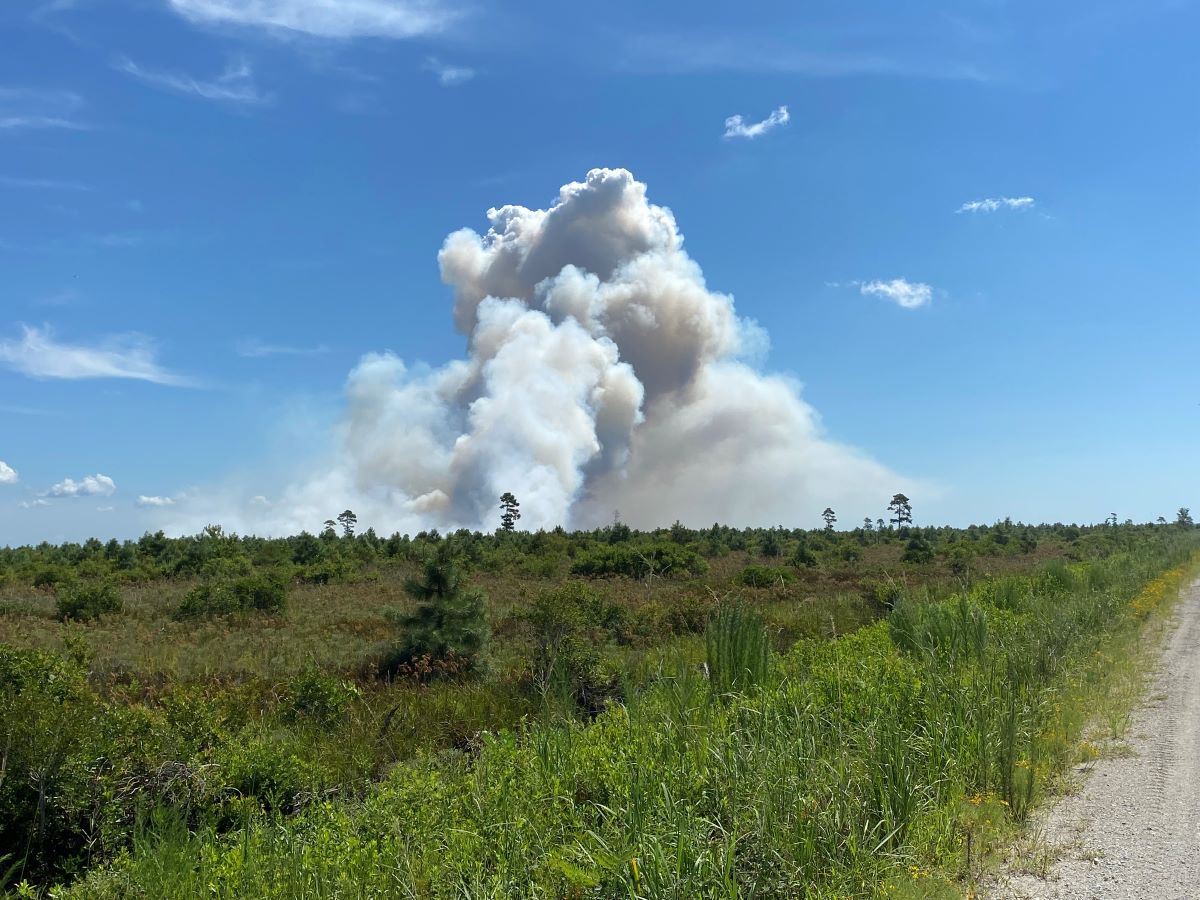
First of two parts
As the fall wildfire season begins in North Carolina, the lead agency that responds to these uncontrolled fires in natural areas encourages residents be vigilant while burning outside.
Supporter Spotlight
“I’d like to remind folks about the importance of exercising caution with all outdoor fires, especially yard debris burns,” North Carolina Forest Service Division Public Information Officer Philip Jackson told Coastal Review.
Human activity causes 99% of North Carolina’s wildfires. Of that 99%, nearly half are caused by careless debris burning and escaped yard debris burns, which is the leading cause of wildfires across the state each year, Jackson said. The other 1% of uncontrolled fires are caused by natural ignition such as lightning.
“Fire activity has remained low over the last few weeks due to tropical storms and other rain events. However, as is the case most year’s during the month of October, we expect October to dry out some over the coming weeks, increasing fire activity,” Jackson said Wednesday.
Assistant State Climatologist Corey Davis told Coastal Review that there are three main components that each make for ideal wildfire conditions in eastern North Carolina: the time of year, the weather, and the ecosystem.
From late February through mid-April, grasses and other vegetation are coming out of their winter dormancy. Before the vegetation becomes fully green, they’re still pretty dry and flammable.
Supporter Spotlight
Deciduous trees are budding during this time, as well. But again, before the leaves have fully emerged, the leaves and trucks are fairly flammable. Without those leaves, they don’t offer as much shade for the vegetation beneath them, which helps it dry out even more, Davis explained.
These circumstances lead to the weather component.
“Warm and sunny days during the spring can cause environmental conditions to dry out more quickly, and as we receive more direct sunlight throughout the season, that can also cause fast-drying conditions in our forest fuels, which includes that not-yet-green vegetation and any dead woody material or litter covering the ground,” Davis said.
In addition to having those summer-like characteristics such as hot days with lots of sunshine, the spring is ultimately a transition season, and one feature of the winter climate that can carry over into the spring is lower relative humidity. “When we get one of those less humid air masses in place during the spring, especially after a warm period, then those dry fuels can be especially crispy and ready to burn,” Davis explained.
Last, there are a few different types of ecosystems in eastern North Carolina where we typically expect to see wildfires. Much of the southern and central coastal plain was once covered by native wiregrass pine savannas, where fires are a natural and common feature, happening every two to five years.
At low intensity, these fires are beneficial since they clear out competing vegetation and thin out the canopy so that native species like Carolina wiregrass and longleaf pines can thrive.
“Over the past century or so, the prevalence of these longleaf pine ecosystems has drastically declined across the region, Davis explained. This is because the trees were cut down initially for timber and naval stores such as tar, pitch, and turpentine, and more recently because of conversion to agricultural lands and other development.
“Where we do still have wiregrass ecosystems, the longleaf pines have been replaced by less fire-tolerant species such as loblolly, so fires may not be as effective. Historical fire suppression in these areas means that more fuels have built up within them, so when they burn now, it tends to be at higher intensity, which is both less beneficial and more likely to become difficult to control or contain,” Davis said.
The other major fire-prone ecosystems in eastern North Carolina are the pocosins near the coastline in places like the Pocosin Lakes National Wildlife Refuge in Hyde, Tyrrell and Washington counties.
“These are fairly low-lying areas where the water table is usually very high, often submerging the soils and creating a peat swamp sort of environment. But during times of drought, the water table drops and that highly organic soil dries out, which makes it very easy to burn,” Davis said.
These types of wildfires are tough to contain because of how remote and inaccessible many of these locations are, and because the fire can burn into the ground and consume the soil itself.
“There’s no easy way to extinguish them except for flooding the soil with as much water as possible or waiting for help from the rain so the water table rises again. Until that happens, these fires can burn and smolder for weeks or months, all while releasing lots of smoke that can be carried by the winds to different corners of the state,” Davis said.
“For those reasons, these pocosin areas have historically seen our state’s largest wildfires, and continue to be an area of concern any time there’s a springtime dry spell,” such as the April 2023 fire in the Croatan National Forest.
“Putting all of that together, the perfect conditions for wildfires in eastern North Carolina would be in late March or early April following a month or so of unseasonably warm and dry weather.”
Davis continued that with vegetation either dormant, dead or not green just yet, the environment would be highly flammable.
“The spark for fires could come from human activity like debris burns, or on a larger scale from lightning strikes along a strong cold frontal passage. Behind that front, a dry and less humid air mass would move in, and gusty winds would spread any newly ignited fires quickly across the landscape,” he said.
By late September, “these same trends from the spring happen again, but in reverse. Our temperatures can remain relatively warm well into October, and once trees drop their leaves, they ramp up the fuel loading at the surface,” according to the climate office.

So far in 2024, the Forest Service has responded to more than 3,500 wildfires for roughly 13,000 acres, Jackson with the Forest Service said.
The 2023 fall wildfire season was extremely active with nearly 2,000 wildfires statewide, more than 1,200 of which burned in November 2023 alone, Jackson said. “That was during our traditional fall wildfire season where fire risk is elevated, but we had also experienced prolonged drought conditions for much of the fall last year.”
“This is consistent and on pace with what we typically see each year. We usually experience between 4,500 and 5,500 wildfires annually. Frequency and duration are heavily influenced by weather conditions and time of year,” Jackson said, adding that over the last two months, “we’ve seen 119 wildfires for less than 50 acres. That’s considered to be rather quiet in terms of new wildfire starts and minimal acreage, largely due to the amount of rain our state has received recently.”
Jackson said that there’s a common misconception that wildfires are only an issue in the Western United States.
“The American South experiences more wildfires each year than any other region in the U.S.,” Jackson said. “While wildfires in the Western U.S. tend to be more severe while consuming larger chunks of acreage, wildfires in the Southeast U.S. are becoming more common.”
North Carolina had the third most wildfires nationally in 2022, behind only Texas and California. That same year, Texas, California, North Carolina, Georgia and Oklahoma accounted for nearly half of the total wildfires in the U.S.
The wildland-urban interface a big reason why. The wildland-urban interface, or WUI, is where development meets forestland. Three of the top four states with the most homes in the wildland urban interface are states located in the South, with North Carolina in the lead.
“North Carolina remains the leading state in the U.S. relative to number of acres in the wildland urban interface. As North Carolina’s population continues to grow, we’ll likely see more people living and recreating in the wildland urban interface,” Jackson said.
With almost all wildfires in the state correlating with human activity, as the population increases, more people living and recreating in the wildland urban interface, potentially resulting in an increase in the number of wildfires our state experiences.
Statewide, between 2010 and 2020, 41,551 wildfires burned 399,125 acres, and from 1990 to 2010, North Carolina saw an increase of 3,005,048 acres in the wildland-urban interface.
“North Carolina’s WUI Risk Index estimates 2.3 million acres are at risk for moderate to major impacts from wildfires to people and their homes,” Jackson said.







